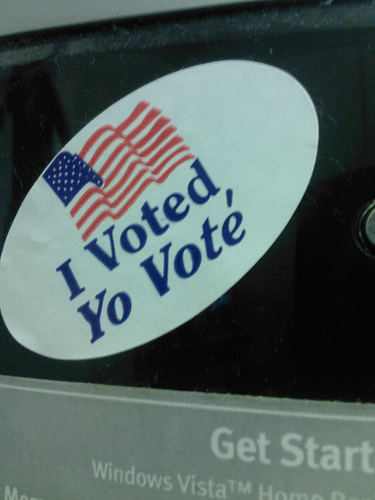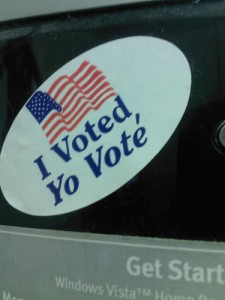Voting Rights Act: The State Of Section 5

 By Suevon Lee, Pro Publica
By Suevon Lee, Pro Publica
A single provision of the Voting Rights Act of 1965 has been playing a key role on the election front this year. Section 5 has blockedphoto voter-ID laws, prohibited reduced early-voting periods in parts of Florida and just Tuesday barred new redistricting maps in Texas.
It’s the reason South Carolina is in federal court this week to try to convince a three-judge panel its photo voter-ID law will not disenfranchise minorities. It’s the reason thatTexas went to trial on the same issue last month — and on Thursday, lost.
 Not surprisingly, then, Section 5 is increasingly the target of attack by those who say it is outdated, discriminatory against Southern states and unconstitutional.
Not surprisingly, then, Section 5 is increasingly the target of attack by those who say it is outdated, discriminatory against Southern states and unconstitutional.
Under the provision, certain states and localities with a history of anti-minority election practices must obtain federal approval or “preclearance” before making changes to voting laws. In present day, that requirement is burdensome, “needlessly aggressive” and based on outdated coverage criteria, two petitions filed in July with the U.S. Supreme Court argue.
Section 5 applies to nine states — Texas, South Carolina, Arizona, Georgia, Louisiana, Mississippi, Alabama, Virginia and Alaska — and currently to parts of Florida, California, New York, North Carolina, South Dakota, Michigan and New Hampshire. The original coverage formula looked at whether states imposed unfair devices like literacy tests in November 1964, whether less than 50 percent of the voting-age population was registered to vote as of that date, or if less than 50 percent of eligible voters voted in the November 1964 presidential election. In 1975, the formula expanded to include jurisdictions that provided election materials only in English when members of a language minority made up more than 5 percent of voting-age citizens.
Momentum is building at the highest levels to narrow or even eliminate this provision. In a 2009 majority opinion to a Section 5 challenge from Northwest Austin Municipal Utility District No. 1 in Texas, U.S. Chief Justice John Roberts wrote that preclearance and the coverage formula “raise serious constitutional questions,” though the justices didn’t settle them at the time. In January, in a separate concurrence to the judgment in the Texas redistricting case, Justice Clarence Thomas stated that Section 5 is unconstitutional (for more on how that case reached the Supreme Court, see our previous explainer).
Shelby County in Alabama and several citizens of Kinston, N.C., have asked the Court to review the constitutionality of Section 5 during this fall’s term.
Last week, six states covered under Section 5 filed an amicus brief to the Shelby County petition, citing the time and cost of seeking preclearance and a voting landscape that’s shed its racist past. Several former Justice Department officials, all of whom served in past Republican administrations, cite in another amicus brief the disparate impact the provision has on the states.
So, could this Civil Rights-era provision soon be on its way out the door? As early as 2009, UC-Irvine law professor Rick Hasen laid out a scenario under which that could happen. But the prospects remain murky.
There is reason to believe the Court’s conservative majority is inclined to strike down Section 5, a supposedly temporary safeguard first enacted in 1965 for a five-year stretch. (It was most recently reauthorized in 2006 for another 25 years when Congress renewed the Voting Rights Act under strong bipartisan support.)
Conditions have “unquestionably improved,” Roberts wrote in his NAMUDNO opinionthree years ago. “Things have changed in the South. Voter turnout and registration rates now approach parity. Blatantly discriminatory evasions of federal decrees are rare. And minority candidates hold office at unprecedented levels,” he said.
Some legal experts say those comments have since encouraged states toward bolder action.
“The cases challenging Section 5 are sprouting up throughout the lower courts, partly in response to the Court’s earlier decision,” said Richard Pildes, a professor at NYU School of Law who co-edited the book, “The Future of the Voting Rights Act.” “I think the Court will feel a responsibility to bring clarity to these momentous issues by returning to the constitutional question and resolving it.”
Before making any changes to criteria for voter registration, voting eligibility, the counting of votes or redistricting, covered states and jurisdictions must get preclearance from the Justice Department or from a panel of judges at the U.S. District Court for the District of Columbia.
Covered states have the burden of proving that any voting law changes lack a discriminatory purpose or effect and wouldn’t “diminish a minority group’s ability to elect a favored candidate.”
That’s the reason why on Tuesday, a panel of federal judges in D.C. refused to allow Texas’s redistricting plan: It ruled that the redrawn maps would dilute the impact of black and Hispanic votes and that legislators could well have had a discriminatory purpose when they drew up these new districts. Texas has said it will appeal the ruling to the Supreme Court.
The Justice Department has objected to a substantial number of proposed voting plans over the last few decades from states seeking administrative preclearance. Between 1970 and 2000, the DOJ raised nearly 1,000 objections to proposed changes; many plans were later withdrawn.
States also have the option to seek a favorable judgment from the federal court in Washington, D.C. — a costlier, longer and, therefore rarer, route to take.
Although there’s been a large drop-off in the number of DOJ objections since 2000, the recent surge of voting law changes have helped bring Section 5 back into the national spotlight. After Florida passed a statewide law reducing its early-voting period from 12 to eight days, a three-judge federal panel said the rule couldn’t take effect in five covered counties, unless the state submitted a revised plan in which those counties extended their voting hours to 12 hours a day during that period.
The DOJ has already opposed voter-ID laws in South Carolina and Texas, arguing they will disenfranchise minorities since that’s a group more likely to lack valid photo identification. On Thursday, a three-judge panel that heard the Texas case agreed, calling the state’s voter ID law “the most stringent in the country.” Texas said it will appeal the decision to the U.S. Supreme Court.
Justice Department preclearance is also pending for a voter-ID law in Mississippi.
Recently, the DOJ gave the green light to Virginia’s voter-ID law, which, unlike some other states, accepts non-photo IDs such as a utility bill or pay stub with a printed name and address.
Critics of Section 5 say that it’s unfair to require covered jurisdictions to undergo preclearance when states like Indiana, Ohio and Pennsylvania, which are not bound by the provision, have enacted just as tough or tougher voting laws.
In non-covered states, challenges to such voter-ID laws can always be brought underSection 2 of the Voting Rights Act, but the burden to prove minority voter infringement falls onto the plaintiffs, not the state or local government as is the case for states and other jurisdictions covered under Section 5.
It’s not just large-scale changes like photo voter-ID laws and redistricting to which Section 5 extends, either — it applies to even incremental changes at the local level. For instance, when the Pitt County School District in North Carolina wanted to reduce in 2011 the number of school board members from 12 to seven and shorten their terms of office, the DOJ objected on grounds the changes would decrease representation of minority-preferred candidates on the school board.
It’s at these local levels where elimination or dilution of Section 5 may be most consequential.
Michael Pitts, a law professor at Indiana University, told ProPublica that it’s “really speculative” to predict the long-term consequence of a narrowing of Section 5. “I suspect that there would be more discrimination in lower profile places, like school boards and town councils and smaller city councils,” he said. “The further away you get and the less high profile it is, the more the influence of having to go that route makes the difference for racial minorities.”
This article was first published in Pro Publica.
ProPublica is an independent, non-profit newsroom that produces investigative journalism in the public interest. Our work focuses exclusively on truly important stories, stories with “moral force.” ProPublica is led by Paul Steiger, the former managing editor of The Wall Street Journal. Stephen Engelberg, a former managing editor of The Oregonian, Portland, Oregon and former investigative editor of The New York Times, is ProPublica’s managing editor. Richard Tofel, the former assistant publisher of The Wall Street Journal, is general manager.
[Photo by College Park Speed and the…]
